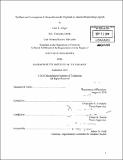Synthesis and investigation of hexacarboxamide cryptands as anionic binucleating ligands by Glen E. Alliger.
Author(s)
Alliger, Glen E. (Glen Edward)
DownloadFull printable version (15.51Mb)
Other Contributors
Massachusetts Institute of Technology. Dept. of Chemistry.
Advisor
Christopher C. Cummins and Daniel G. Nocera.
Terms of use
Metadata
Show full item recordAbstract
We have investigated the use of hexacarboxamide cryptands as sextuply anionic binucleating ligands. Two homobimetallic complexes of a t-butyl-substituted cryptand, featuring manganese(II) ion and cobalt(II) ions, have been synthesized. The manganese species features a bridging hydroxide ligand; both of these species have been structurally characterized, though complete characterization was not possible due to the compounds' impurity. A highly soluble hexacarboxamide cryptand, featuring dipropoxyphenoxyl substituents, was synthesized for the first time, and has been structurally characterized. The structure features a two-dimensional hydrogen bonding network, resulting in infinite sheets of cryptand units. We have synthesized a dicobalt(II) complex of this ligand. This compound features the metal centers in cofacial trigonal monopyramidal geometries, with an intermetallic distance in excess of 6 A. This marks the first time that such a species has been fully characterized. Despite the void between the metal centers, elucidation of constructive reactivity was a challenge, though insertion of cyanide under forcing conditions was achieved. This dicobalt(II) p-cyano complex was also structurally characterized. Using the methodology set forth for the synthesis of the dicobalt(II) complex of the soluble cryptand, we have synthesized a series of complexes of this ligand, featuring manganese(II), iron(II), nickel(II), and zinc(II). These compounds were structurally characterized, and were found to be isomorphous with the dicobalt(II) complex. A comparison of the structures is drawn. These compounds have also been characterized by a variety of methods, including SQuID magnetometry, cyclic voltammetry, EPR, and, in the case of the diiron complex, Mbssbauer spectroscopy. Also reported is work toward a diiron(III) complex; the M6ssbauer spectrum of this species is reported. In analogy to the pt-cyano complex of the dicobalt complex above, a p-cyano complex of the diiron(II) was synthesized and structurally characterized. Investigations into the utility of the initial t-butyl substituted cryptand as a ligand have also been made. Initial results indicate that monometalation of this ligand is possible, and treatment of a putative monocobalt(II) complex with tetrabutylammonium cyanide suggests that the cyanide-bound product is in equilibrium with the free complex.
Description
Thesis (Ph. D.)--Massachusetts Institute of Technology, Dept. of Chemistry, 2010. Vita. Cataloged from PDF version of thesis. Includes bibliographical references.
Date issued
2010Department
Massachusetts Institute of Technology. Department of ChemistryPublisher
Massachusetts Institute of Technology
Keywords
Chemistry.